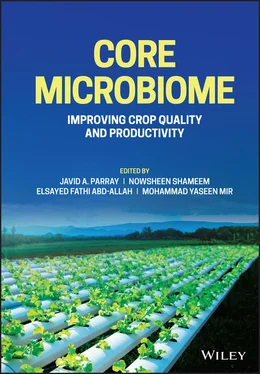1 ...7 8 9 11 12 13 ...25 Furthermore, in another study, the endophytic B. subtilis strain E1 R-j was administered to determine its inhibitory effect on the causative agent of wheat stripe rust disease Puccinia striiformis [74]. In-vitro studies revealed an 84.1% inhibition rate when 10-fold dilution of fermentation liquid was used to treat bacterial cells. At the same time, in field trials, a significant decrease in disease severity was observed compared with non-treated plots. Moreover, a seven-month trial period of endophytic Burkholderia cenocepacia 869T2 against Fusarium wilt reduced the disease incidence to 3.4% compared to 24.5% of non-inoculated plants [75]. Similarly, pre-inoculation of peanut with beneficial root endophyte curbed root rot, which was evident from a decrease in the colonization by pathogens, cell death, and disease severity [76].
After a long period of continuous cropping system, a single type of root exudate can lead to an imbalance in the microbial diversity of the soil and can cause soil deterioration. In a greenhouse experiment, exudates from root endophyte Phomopsis liquidambaris improved significantly the rhizospheric abundance of bacteria. They promoted growth in peanuts by alleviating soil sickness [77]. Adopting a rational approach for disease management for sustainable agriculture has vast potential in the future. One of the benefits of using microorganisms is their role in declining agrochemicals, making agricultural practices more viable. An extensive field trial using inoculants containing an endophytic strain of Rhizobium leguminosarum bv. Trifolii enhanced grain yield in 19 tests out of 24, thus promoting rice production capacity and curtailing the necessity of chemical N-fertilizer inputs [78]. Muscodor albus , a novel endophytic isolate, is already registered and patented by Marrone Bio Innovations as a potent mycofumigating agent. Many studies have reported its potential as a biofumigant [79,84,80].
2.4 Plant–Microbe Interaction in the Phyllosphere
“Phyllosphere” is an ancient Greek word. “Phyllo” means leaf, and “sphere” refers to the field of influence. The term “Phyllosphere” referred to the above-ground part of a plant and was coined by Last and Ruinen in the 1950s in “Analogy to the Rhizosphere” [81,82]. The phyllosphere is associated with the largest biosphere–atmosphere interphase on Earth and is dominated by aerial plant parts, such as leaves, flowers, fruits, and others. The phyllosphere microbiota interacts with host and other microbes to colonize outer plant surfaces in addition to biotic, abiotic, and anthropogenic factors. Most biomes reach the phyllosphere via soil, wind, water, or insect transmission [83]. Leaf microbiotas first interacts with the outer cuticular layer, and the leaf micro-environment determines microbial communities [84]. Stomatal opening and wounds on the leaves surface are the primary paths for microbiota entering the inner phyllosphere [85]. Leaf exudates, such as terpenes, benzenoids, methanol, sugar, amino acids, and organic acids, also shape phyllosphere microbial assembly [86].
2.4.1 Microbial Population in the Phyllosphere
Microbial populations associated with aerial parts of plants have been known as epiphytes [87]. Proteobacteria, Actinobacteria, Bacteriodetes , and Firmicutes are consistent microbial phylotypes [88]. 16S rRNA sequencing has provided information about important phyllosphere colonizing bacteria, including diazotrophic and methylotrophic bacteria viz., Beijerinckia and Methylobacterium that consume nitrogen and methanol compounds, respectively [89]. Methylobacterium , Sphingomonas , and Pseudomonas are the most dominant genera in the phyllosphere microbial diversity, which possess specific adaptation factors to the phyllosphere [90,91]. For instance, the Sphingomonas spp . manage to survive in a nutrient-deficient environment by metabolizing many carbon sources [90]. Similarly, Pseudomonas spp . can move at auspicious sites by using flagellar motility [92]. The most enriched fungal communities in the phyllosphere are Ascomycota and basidiomycetous yeasts, and the most common genera are Cladosporium, Aureobasidium , and Taphrina [85].
2.4.2 Biocontrol Mechanism in the Phyllosphere
The plant immune system plays a crucial role in controlling phyllosphere diversity [93]. Phyllosphere microbiota has adapted against extreme environmental conditions along with biocontrol activity that contains pathogenic microorganisms. A large amount of the inhibitory strains carries gene clusters encoding metabolites with prophylactic effects. The Brevibacillus sp . was reported to produce several antimicrobial compounds, such as marthiapeptide A, streptocidin D, and an unusual lysophospholipid that acts on gram-negative bacteria [94].
Leaf exudates are carbon sources for both resident microbiota and pathogens, which allow plant–microbe and microbe–microbe interaction. Competition for carbon source determines the phyllosphere community; for example, methylotrophic yeast Candida boidinii in Arabidopsis thaliana and Methylobacterium extorquens in the rice phyllosphere can metabolize methanol compounds emitted by plant leaves and survive on the leaves [95,96].
Parasitism acts by producing antagonistic agents that can parasite other fungi and feed on them. Biocontrol agents either destroy fungal propagules or cause partial obstruction and lysis of pathogen structure by producing hydrolytic enzymes. The host plant also acquires a defense mechanism by delivering chitinases and β-1,3-glucanase, which act on pathogen cell walls [97]. Under field conditions, strawberry plants are protected by Bacillus subtilis against Bacillus cinerea by the secreting extracellular enzymes viz ., chitinase and proteases [98]. Moreover, five species of Tilletiopsis from the phyllosphere have antagonistic activity against powdery mildew by producing chitinase and endo- and exo- β-1,3-glucanase [99].
Microorganisms with antagonistic activity suppress the growth of phytopathogens and inhibits the subsequent development and activity of infectious agents. The richness of bacterial species and negative interactions positively promote the growth and development of the plant [100]. Moesziomyces albugensis carries potent antagonistic activity against the oomycete pathogen Albugo laibachii in the phyllosphere of wild A. thaliana [101]. Trichoderma strains with the antagonistic potential of secreting cell-wall hydrolyzing enzymes such as chitinases, proteases, and β-glucanases can degrade the cell wall of pathogens [102].
Pseudomonas strains directly inhibit wide variety of pathogens (i.e., P. syringae and B. cinerea ) in the laboratory as well as infield [103,104]. Pseudomonas spp. produced phenazines, a group of heterocyclic secondary metabolites that antagonize phytopathogens [105]. The Pseudomonas spp. is also reported to produce many other potential biocontrol metabolites, i.e., siderophores, 4-hydroxy-2-alkylquinolines, cyclic lipopeptides, and rhamnolipids, which are a class of biosurfactants [106]. Xanthomonas oryzae pv. oryzae is responsible for bacterial blight, which is the most destructive and serious disease-affecting rice. Among bacteria, actinomycetes are gram-positive and produce 70% of the compounds with biological effects. A total of eight strains of actinomycetes are reported to have shown a positive effect on controlling Xanthomonas in vitro and reducing disease severity of bacterial leaf blight. STG-15 can control bacterial leaf blight incidence and is identified as Nonomuraea sp [107].
Читать дальше











